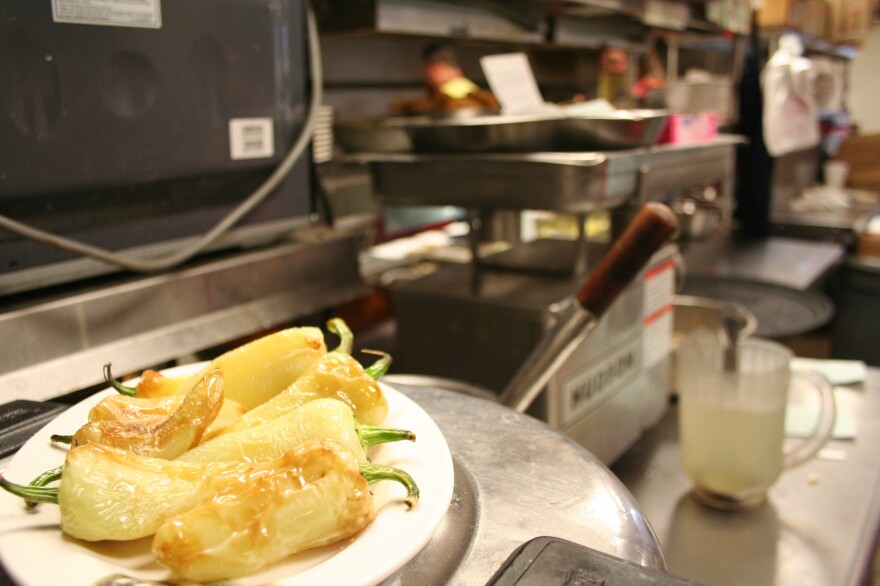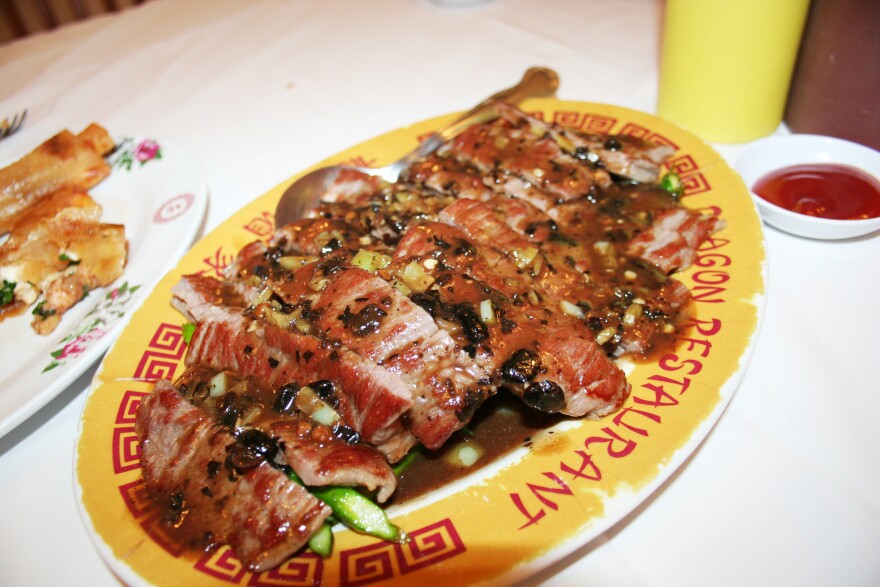If you ask people in the city of Mexicali, Mexico, about their most notable regional cuisine, they won't say street tacos or mole. They'll say Chinese food. There are as many as 200 Chinese restaurants in the city.
North of the border, in California's rural Imperial County, the population is mostly Latino, but Chinese restaurants are packed. There are dishes in this region you won't find anywhere else, and the history behind them goes back more than 130 years.

The Salcedo family sits in a coveted booth at the Fortune Garden restaurant in the city of El Centro, north of the border. The mother and three adult sisters are almost drooling, waiting for their food to show up. They come from Yuma, Ariz.— over an hour away — twice a month just to eat here.
A huge side order arrives, light-yellow deep-fried chilis, a dish I've never seen. Then a salt-and-pepper fish, which the Salcedos describe as "Baja style," with lots of bell peppers, chilis and onions. But have you ever heard of Baja-style dishes in a Chinese restaurant?
Mayra Salcedo explains, "It's like a fusion, Mexican ingredients with the Chinese. It's very different than if you go to any other Chinese restaurant, Americanized Chinese restaurant."

"When they order, they don't say barbecue pork," says Fortune Garden co-owner Jenissa Zhou. "They say carnitas — carnitas coloradas." That's "red pork" in Spanish.
Zhou came to the U.S. from southern China. Her husband, Carlos, is from Mexicali, where he worked in Chinese restaurants. It took her a while to get used to her customers' taste buds.
"You can see, every table, they have lemon and hot sauce," Zhou says. "In Chinese food, we don't eat lemon."
Those fried yellow chilis on almost every table, chiles asados, are served in a lemon sauce with lots of salt — kind of a margarita flavor. If you believe the rumors, some chefs marinate pork in tequila.
It's not just on the plate where cultures combine. In the Fortune Garden kitchen, the cooks speak to each other in Cantonese. The waiters speak Spanish and English.
Today's Border Patrol grew out of the Mounted Guard of Chinese Inspectors, created to keep Chinese immigrants from entering the U.S.
"The restaurants you see now are remnants of the Chinese population that used to fill the U.S.-Mexico borderlands in Mexicali and in Baja California," explains Robert Chao Romero, a professor at the University of California, Los Angeles. He teaches in both the Chicano and Asian-American studies departments and wrote the book The Chinese in Mexico.
And just why were the Chinese there? Because of the Chinese Exclusion Act.
Spurred by anti-Chinese laborer sentiment among American workers, the 1882 law banned immigrants from China from entering the U.S. Tens of thousands went to Cuba, South America and Mexico instead. Many settled along the U.S.-Mexico border, becoming grocers, merchants and restaurant owners. Others managed to cross illegally and make lives in the U.S., including in Imperial County.

"The Chinese invented undocumented immigration from Mexico," says Romero. He says they were smuggled in with the help of guides hired to lead them across the border. "Smuggling with false papers, on boats and trains — the infrastructure for that was all invented by the Chinese."
Today's Border Patrol grew out of the Mounted Guard of Chinese Inspectors, created to keep Chinese immigrants from entering the U.S. At the same time, the Mexican government welcomed Chinese immigrants to go to the sparsely populated border region, to work on farms and in mines and canals.
The Chinese-Mexican cuisine this history begot is even more prominent on the Mexican side of the border, as I learn while taking a drive over the border with George Lim. He lives in the U.S. but commutes every day to Mexicali. Lim helps run one of the city's oldest: El Dragon.
Why cross the border every day to run a restaurant? Lim explains that Mexicali's population is nearly 1 million, which dwarfs the rural population on the California side of the border.

"Just doing the math, you're going to have a lot more customers here in Mexico," he explains. "And I hate to say it, but people in Mexico are more sophisticated than in Imperial about Chinese food."
That sophistication may come from decades of people eating Mexican-influenced Chinese food here. Once, it was a necessity: Chinese cooks used Mexican ingredients like chilis, jicama and certain cuts of meat, because that was what was available. Now it's part of a culinary legacy.
There's a new dish at El Dragon: arrachera beef, served with asparagus and black bean sauce. Lim says that's the best meat for tacos, a clear Mexican influence: "Asparagus could be both Chinese and Mexican, but the sauce, the black bean, that's Chinese."
I try out a kind of Mexican-Chinese-American hybrid: an egg roll with shrimp, cilantro and cream cheese that seems like it shouldn't be good, but is. And at El Dragon, they put avocado in the fried rice.
Lim says people still come from China to work in Mexicali restaurants, and sometimes these cooks move up north, to work in Chinese kitchens in Imperial County.
"One of the goals is to go to the U.S., have a better life for you and for your kids, give them a better education, better opportunity, maybe earning dollars instead of pesos," he says.
The same reasons, in other words, that drew their ancestors here from southern China 130 years ago.
This story first ran on KQED's The California Report. Vickie Ly helped with reporting and translation. Theseries "" is supported in part by . Lisa Morehouse, an independent journalist, produced this story during a fellowship at , a residency for female writers.
Copyright 2020 NPR. To see more, visit https://www.npr.org.


